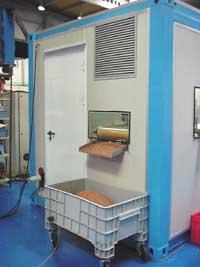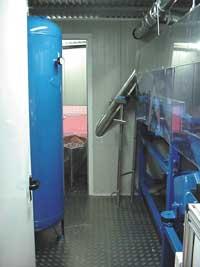Artificial vision for copper recycling

In these times recycling is given great importance, not only for its environmental benefit, but also for its economic interests: sometimes it is cheaper to obtain the material from recycled elements than from raw materials. This is the case of some metals. In fact, metal recycling is known as the new mining, since waste is like minerals, source of metal. The best known example is scrap recycling.
The copper wire that leads the cables is highly appreciated. In addition, the change of conventional telephone lines has driven the recycling of cables. However, the price of the recovered material depends on the degree of purity achieved. In fact, in most recycling systems, recovered copper contains other mixed metals, limiting its subsequent use.
Cable recycling companies take several steps to get copper. First the wires are uncovered, then the wires are broken, they are cribed and separated according to the density, leaving finally the mixture of crushed metals. Most of this mixture, more than 90%, is copper, while the rest is composed of other metals, mainly lead, tin and aluminum. Copper of this degree of purity is valid for plumbing sections and other uses, but not for electrical uses. The degree of purity required for this is much higher than 99.9%.

Mechanical methods of separation of impurities (gravimetry, sifting, etc.) or physical (electric fields) are insufficiently effective and distribution by chemical methods is highly polluting. At first glance, on the contrary, the minerals mixed with copper are observed. Robotiker researchers have taken advantage of this and have prepared an artificial vision system for high purity copper.
Artificial eye separating colors
Since the most problematic impurities are lead, the method developed in Robotiker is oriented to the separation of them. Once the wire is shredded, small particles are mixed, clearly separating the copper red particles from the greyish particles containing other minerals.
All these particles pass to the first point of the system. Here the material is prepared to enter the second zone, passing first through the sieve of removing excessively large particles and then, by means of a vibrator, the mixture of particles is distributed in the conveyor belt.
In the second zone is the artificial vision system, an image processor and an absorption module, whose activities are fully synchronized. Once the particles enter this second zone, a color sensor picks up the image of the particles that are separated into the tape. This image passes to a processor and depending on the colors the exact position of all non-copper particles is known. This information will be transferred to the next absorption module.
When the conveyor belt reaches the place where the vacuum cleaner group is located, following the instructions given by the processor, all non-copper particles are absorbed. Of course, some copper is also absorbed with lead. Vacuum cleaners clean more than 90% of the original lead.

The copper that finally remains in the tape is very pure: Its purity is higher than 99.9%. As a result, it is used for applications that require high purity, such as cathodes, electrolytic processes, batteries, etc.
The complete system has three outputs: one initial for the collection of large particles that do not pass through the sieve, another for the collection of those captured by the vacuum cleaners and the third, which gives the final result of the process. In addition, the entire system is inside a container, so that it can be transported with a truck to the desired location.
Collaboration success
Laining Industrial and Botrade and Indumental Recycling have collaborated with Robotiker to develop the project. These last two are recycling companies that wanted to obtain a copper with more than 99.9% purity. It is clear that they have met the goal.
Artificial vision is the latest technology. In this case, copper has been applied to recycling and, as a satisfactory result, may in the future be extended to other recycling processes.





